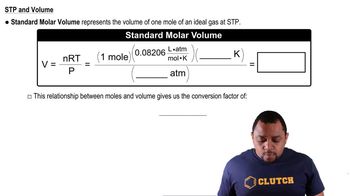Use data from Appendix IIB to calculate ΔS°rxn for each of the reactions. In each case, try to rationalize the sign of ΔS°rxn. c. SO2(g) + 1/2 O2(g) → SO3(g)
Ch.18 - Free Energy and Thermodynamics

Chapter 18, Problem 58
What is ΔS° for the reaction between nitrogen gas and fluorine gas to form nitrogen trifluoride gas, and how can the sign of ΔS° be rationalized?
 Verified step by step guidance
Verified step by step guidance1
Key Concepts
Here are the essential concepts you must grasp in order to answer the question correctly.
Entropy (ΔS)
Entropy, denoted as ΔS, is a measure of the disorder or randomness in a system. In chemical reactions, it reflects the number of ways the particles can be arranged. A positive ΔS indicates an increase in disorder, while a negative ΔS suggests a decrease in disorder. Understanding how the states of reactants and products influence entropy is crucial for predicting the sign of ΔS in a reaction.
Recommended video:
Guided course

Entropy in Thermodynamics
Gaseous State and Molar Volume
The gaseous state of matter has a higher degree of freedom and disorder compared to solids and liquids. When gases react, the change in the number of moles of gas can significantly affect the overall entropy. In the reaction between nitrogen gas and fluorine gas to form nitrogen trifluoride gas, the change in the number of gas molecules must be considered to determine the sign of ΔS.
Recommended video:
Guided course

Standard Molar Volume
Reaction Stoichiometry
Reaction stoichiometry involves the quantitative relationships between reactants and products in a chemical reaction. For the given reaction, analyzing the stoichiometry helps in understanding how the number of moles of reactants and products changes. This change is essential for rationalizing the sign of ΔS, as it directly influences the overall disorder of the system.
Recommended video:
Guided course

Stoichiometry Concept
Related Practice
Textbook Question
Textbook Question
Use data from Appendix IIB to calculate ΔS°rxn for each of the reactions. In each case, try to rationalize the sign of ΔS°rxn. d. N2O4(g) + 4 H2(g) → N2(g) + 4 H2O(g)
Textbook Question
Find ΔS° for the formation of CH2Cl2(g) from its gaseous elements in their standard states. Rationalize the sign of ΔS°.
Textbook Question
Methanol (CH3OH) burns in oxygen to form carbon dioxide and water. Write a balanced equation for the combustion of liquid methanol and calculate ΔH°rxn, ΔS°rxn, and ΔG°rxn at 25 °C. Is the combustion of methanol spontaneous?
2
views
Textbook Question
In photosynthesis, plants form glucose (C6H12O6) and oxygen from carbon dioxide and water. Write a balanced equation for photosynthesis and calculate ΔH°rxn, ΔS°rxn, and ΔG°rxn at 25 °C. Is photosynthesis spontaneous?
1
views
